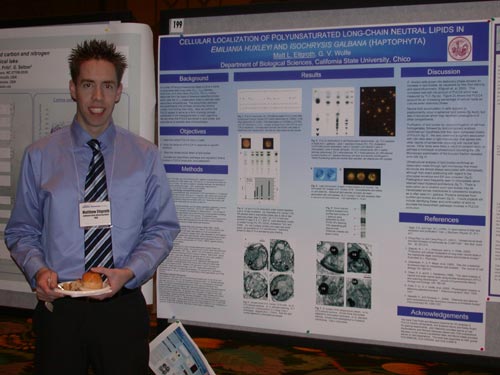Lipid
Biology of Marine Algae |
 |
Neutral
Lipids of Emiliania huxleyi
With Fred Prahl, Oregon State University |
Some haptophyte algae (Isochrysis, Emiliania, Gephyrocapsa, Chrysotila) produce a suite of polyunsaturated long-chain (C37-C39) alkenes, alkenones, and alkenoates, which we term PULCA. These compounds are unlike the cis-polyunsaturated fatty acids (PUFA) typical of eukaryotic membrane constituents in that they have 2-4 unusual trans alkene bonds occurring at 7-carbon intervals.
At colder growth temperatures,
PULCA are more highly polyunsaturated, and the proportion of diunsaturated
isomers of the C37 methyl alkenones (the ‘unsaturation index’
UK’37) from marine coccolith-bearing sediments is widely used by
geochemists as a proxy for surface water paleotemperatures. However, the
calibration of unsaturation index also depends on strain genetics and
environmental factors, and the utility of this tool remains limited.
We are investigation the biology of these interesting compounds. This
is especially timely since Emiliania
huxleyi, a cosmopolitan coccolithophorid alga that is
perhaps the dominant calcifying organism on the planet, plays a major
role in the ocean’s food web, carbon and sulfur cycles, and may
even affect climate. Its genome is currently being sequenced by the DOE
(Ehux genomics).
| 1. Current work: lipid body proteins |
| Lipid bodies are now recognized to be dynamic quasi-organelles, organized by proteins such as the TIP family. These proteins have not been characterized for algae, and we are working to characterize proteins associated with lipid bodies of Emiliania and Isochrysis. |
| 2. Cellular localization of PULCA | ||
Matt Eltgroth’s
Master’s thesis examined cells with the lipophilic fluorescent
stain Nile Red to determine the cellular location PULCA. He observed
prominent lipid bodies, which he found from subcellular fractionation
consisted primarily of PULCA. Transmission electron microscopy showed
these lipid bodies appear to originate in chloroplasts and are subsequently
transported to the cytoplasm, and their behavior during nutrient
and light stress mirrors the patterns of PULCA accumulation and
degradation we previously observed (see below). Matt’s work
was presented at the spring 2005 ASLO meeting and published in the
|
|
3. Function of PULCA as neutral lipid |
| By investigating the accumulation of these lipids during batch growth under nutrient, we believe these compounds appear to function for energy storage and as a shunt for excess reducing power when cells are unable to divide. They also appear to fuel metabolism during light limitation, as cellular PULCA stores decline. These behaviors are similar to other neutral lipids, such as triacylglycerides. |
